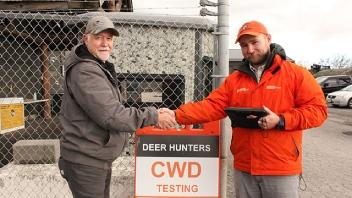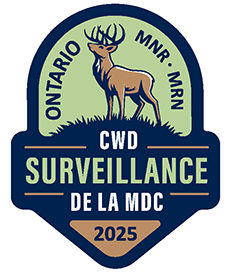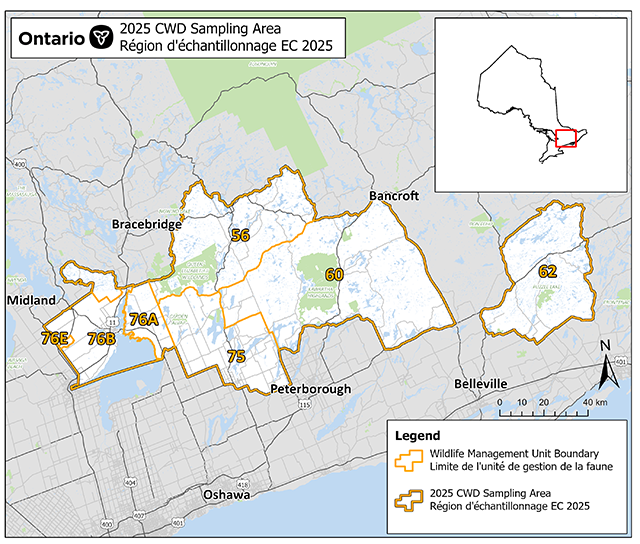Monitoring and testing for chronic wasting disease
Learn about how you can report sick cervids (members of the deer family) and how hunters can get their harvested deer tested.
Overview
Once established in the wild, chronic wasting disease (CWD) is challenging to control or eliminate. If CWD enters Ontario, early detection will be critical for a rapid and effective response.
Our surveillance program includes:
- annual targeted surveillance of high-risk areas of the province with a focus on hunter submissions of harvested white-tailed deer
- testing samples from cervids that display CWD-like signs from across the province throughout the year
- contacting people who register cervid carcasses at Keep a dead wild animal and requesting a sample for testing if they are within an annual CWD surveillance area
- testing dead cervids when the opportunity occurs including roadkill and dispatched escaped captive cervids
- mandatory testing of all farmed cervids at slaughter
Since 2002, we have tested over 16,000 samples from wild cervids and CWD has not been detected. We must remain vigilant because of the risks posed from its continued spread across North America.
Report a sick or dead wild deer, moose, elk or caribou
If you observe these signs in a wild cervid (member of the deer family), or see a dead cervid, submit your sighting by email CWD@ontario.ca or call the ministry's Wildlife Health Information Line at
When reporting sick or dead cervids, include:
- your name and contact information
- the date you saw the animal
- the location the animal was seen
- the signs of illness or unusual behaviour you observed
- if the animal was alive or dead
- photos or video and submit them to CWD@ontario.ca
Testing for CWD
There are currently no approved live tests (such as a blood test) that can definitively diagnose CWD. The tissue that must be tested can only be obtained from an animal after it is dead.
Ontario’s hunters are a key partner in our efforts to monitor for CWD. Learn how to get your deer tested.
Annual targeted surveillance
Each year, we identify priority CWD surveillance areas using a risk model, expert input and information from other jurisdictions. Ontario’s risk model is based on known risk factors linked to the spread of CWD. These risk factors are:
- proximity to neighbouring outbreaks
- deer and elk population density
- presence of cervid farms
- prior sampling effort
- winter deer feeding areas
- winter severity
Each year during the deer hunting season, we collect samples from these surveillance areas. Hunters who harvest a deer from a wildlife management unit within a surveillance area can have their deer tested free of charge. Hunters are the primary source of samples and are critical to Ontario’s efforts to detect CWD.
Note: Fawns under 1 year of age are not tested because CWD is less likely to be detected in young animals.
For more information on CWD monitoring or to submit a sample from one of the CWD surveillance areas:
- call our wildlife health information line at
1-888-574-6656 - email CWD@ontario.ca
How to get your deer tested
We provide 2 options for submitting samples in a surveillance area:
Ministry wildlife technicians
During portions of the firearm hunts, our wildlife technicians travel throughout the surveillance areas visiting hunters and hunt camps to request samples from harvested deer. The technicians ask the hunter’s permission to remove a small amount of tissue from the base of the skull of the deer for analysis. The deer is then returned to the hunter.
Sampling does not prevent hunters from consuming the meat or, in most cases, having the head mounted. Learn more about safe handling, chronic wasting disease and human health.
Ministry freezer depots
Successful hunters in surveillance areas can take the heads of yearling or older deer they harvest and deposit them in one of the ministry freezer depots. Freezer depots have bags to place deer heads into, along with tags that must be filled out with required information and attached to the bag. Hunters who submit a sample at a ministry freezer are provided with a participation crest and a sample ID card.
When submitting heads, hunters:
- are required to provide the date and general location of the harvest using the map provided at the depot —without this information the sample will not be tested
- should make deposits as soon as possible, preferably within 48 hours of harvest or freeze the head until it can be dropped off
- should remove the antlers before submission
- may remove the skull cap if most of the brain, including all of the brain stem, remains in the head
If you harvest a deer within one of the surveillance areas that you would like to have sampled, but you are unable to submit it at a freezer location, contact CWD@ontario.ca or
Test results will be posted to the test results table.
Earn your crest
The first 500 hunters in each surveillance area who provide a tissue sample from a deer taken in a surveillance area will receive a participation crest.
2025 freezer depot locations
In 2025, we will conduct chronic wasting disease monitoring in 2 Ontario regions:
- Central Ontario in Wildlife Management Units (WMUs): 56, 60, 62, 75, 76A, 76B and 76E.
- Southwestern Ontario in WMUs: 94A and 94B.
Check the freezer depots tables for a list of depot locations in each region.
2025 sampling area, Central Ontario
Central Ontario freezer depots
| Name | Address | Phone | Hours |
|---|---|---|---|
| Chesher’s Outdoor Store | 27440 Highway 62, Bancroft | Wednesday to Thursday 11 a.m. to 5 p.m. Friday 9 a.m. to 5 p.m. Saturday 9 a.m. to 2 p.m. | |
| Bishop Lake Outdoors | 13621 Highway 41, Cloyne | Tuesday to Saturday 8 a.m. to 5 p.m. Sunday 9 a.m. to 2 p.m. | |
| Tagged out | 5166 Boulter Road, McArthur Mills | Call for appointment | |
| Trombly’s Tackle Box | 595 West Street South, Orillia | Monday to Friday 9 a.m. 6 p.m. Saturday 8 a.m. to 5:30 p.m. Sunday 10 a.m. to 5 p.m. | |
| Outdoor Plus | 54 York Street, Haliburton | Monday to Friday 8 a.m. to 6 p.m. Saturday 8 a.m. to 5 p.m. Sunday 8 a.m. to 4 p.m. | |
| On the Pond Wildgame Processing | 974 Rogers Road, Tamworth | (texting preferred) | Daily 7 a.m. to 8 p.m. |
| Ralph’s Butcher Shop | 4259 ON-7, Norwood | Tuesday to Sunday 9 a.m. to 5 p.m. | |
| Four Seasons on Wellington and Apsley Outdoors | 137 Peterborough 504, Apsley | Monday to Friday 9 a.m. to 5:30 p.m. Saturday 9 a.m. to 4 p.m. | |
| Boyles Ernest & Sons Ltd. | 2021 Bensfort Road, Peterborough | Monday to Friday 8 a.m. to 5:30 p.m. Saturday 8 a.m. to 2 p.m. |
2025 sampling area, Southwestern Ontario
Southwestern Ontario freezer depots
| Name | Address | Phone | Hours |
|---|---|---|---|
| Roesch Meats and More | 10910 Northwood Line, Kent Bridge | Tuesday to Friday 9 a.m. to 5 p.m. Saturday 9 a.m. to 3 p.m. | |
| Nadeau Farms | 2152 Lakeshore Road 241, Ruscom Station | Thursday to Friday 10 a.m. to 6 p.m. Saturday 9 a.m. to 2 p.m. | |
| Rogue Country Store and Feed | 7593 Pain Court Line, Pain Court | Monday to Sunday 10 a.m. to 6 p.m. | |
| Arner Stop | 1958 Essex County Road 20, Kingsville | Monday to Friday 7 a.m. to 7 p.m. Saturday to Sunday 8 a.m. to 7 p.m. | |
| Country Fresh Packers | 4049 Bonneau Line, Tilbury | Monday to Friday 8 a.m. to 5 p.m. Saturday 8 a.m. to 2 p.m. |
Test results
Testing for 2025 is under way and should be complete by the end of February 2026. Results will be posted as they become available. CWD was not detected in any samples we have tested thus far.
Explanation of results
- CWD not detected
- CWD was not detected in the sample
- Sample not tested
- It was not possible to test this sample or the sample was from outside of the surveillance area
For more information on the ministry surveillance program, or to receive copies of the previous year’s report, please contact us.






